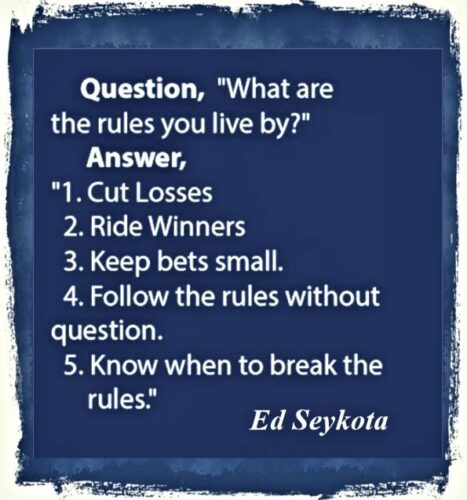
Twenty great trading advice by Donchian & Seykota for successful money trade by Daimontraders blog
Risk is the uncertain possibility of loss. If you could quantify risk exactly, it would no longer be risk.
Ed Seykota
I can only rise by knowledge, If I fall it must be by my own blunders.
Jesse Livermore
As in any other job, art or science, observation is the only foundamental and pragmatic activity to use to guide your actions!
Carl William Brown
Risk no more that you can afford to lose, and also risk enough so that a win is meaningful.
Ed Seykota
Study stupidity and power at large, once you’ve reached the essence of these miserable entities, you can easily and successfully trade almost everything!
Carl William Brown
The most important quality for an investor is temperament, not intellect.
Warren Buffett
It doesn’t matter if you’re trading stocks or soybeans. Trading is trading, and the name of the game is increasing your wealth. A traders job description is stunningly simple: Don’t lose money. This is of utmost importance to new traders, who are often told do your research. This is good advice, but should be considered carefully. Research alone wont ensure a profit, and at the end of the day, your main goal should be to make money, not to get an A in How to Read a Balance Sheet.
Donchian

Donchian & Seykota
1) Beware of acting immediately on a widespread public opinion. Even if correct, it will usually delay the move.
2) From a period of dullness and inactivity, watch for and prepare to follow a move in the direction in which volume increases.
3) Limit losses and ride profits, irrespective of all other rules.
4) Light commitments are advisable when market position is not certain. Clearly defined moves are signaled frequently enough to make life interesting and concentration on these moves will prevent unprofitable whip-sawing.
5) Seldom take a position in the direction of an immediately preceding three-day move. Wait for a one-day reversal.
6) Judicious use of stop orders is a valuable aid to profitable trading. Stops may be used to protect profits, to limit losses, and, from certain formations such as triangular foci, to take positions. Stop orders are apt to be more valuable and less treacherous if used in proper relation to the chart formation.
7) In a market in which upswings are likely to equal or exceed downswings, heavier positions should be taken for the upswings for percentage reasons – a decline from 50 to 25 will net only 50% profit, whereas an advance from 25 to 50 will net 100%
8) In taking a position, price orders are allowable. In closing a position, use market orders.
9) Buy strong-acting, strong-background commodities and sell weak ones, subject to all other rules.
10) Moves in which rails lead or participate strongly are usually more worth following than moves in which rails lag.
11) A study of the capitalization of a company, the degree of activity of an issue, and whether an issue is a lethargic truck horse or a spirited race horse is fully as important as a study of statistical reports.
12) A move followed by a sideways range often precedes another move of almost equal extent in the same direction as the original move. Generally, when the second move from the sideways range has run its course, a counter move approaching the sideways range may be expected.
13) Reversal or resistance to a move is likely to be encountered upon reaching levels at which in the past the commodity has fluctuated for a considerable length of time within a narrow range or on approaching highs or lows.
14) Watch for good buying or selling opportunities when trend lines are approached, especially on medium or dull volume. Be sure such a line has not been hugged or hit too frequently.
15) Watch for “crawling along” or repeated bumping of minor or major trend lines and prepare to see such trend lines broken.
16) Breaking of minor trend lines counter to the major trend gives most other important position taking signals. Positions can be taken or reversed on stops at such places.
17) Triangles of ether slope may mean either accumulation or distribution depending on other considerations although triangles are usually broken on the flat side.
18) Watch for volume climaxes, especially after a long moves.
19) Don’t count on gaps being closed unless you can distinguish between breakaway gaps, normal gaps and exhaustion gaps.
20) During a move, take or increase positions in the direction of the move at the market the morning following any one-day reversal, however slight the reversal may be, especially if volume declines on the reversal.

To find out more about trading and finance you can also read:
Jesse Livermore trading lessons

